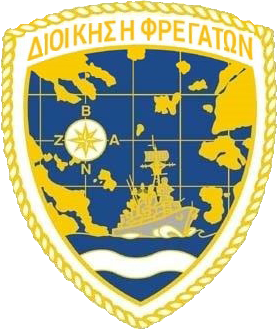Frigate Command

Crest
The crest depicts a frigate sailing “with an unrestrained speed”, symbolizing the immediacy and the ability of the Command to intervene in all operational challenges. As a background, the North Aegean region is shown, where the Naval Units of the Command contributed to the great successes of the Hellenic Fleet during the Balkan Wars, while the compass card symbolises the high level of Nautical Art possessed by the crews of the Frigate Command.
History
The Frigate Command was actually established shortly before the Balkan Wars in the form of the Destroyer Flotilla and consisted of two (2) Squadrons. The Scout Squadron and the Destroyer Squadron.
During the Balkan Wars, the Destroyer Squadron belonging to the Aegean Fleet, based at Moudros Gulf, Lemnos, contributed to the safe transportation of troops and the control of the Dardanelles, ensuring the Greek maritime control of the Aegean. Noteworthy events include the defeat of the Turkish fleet in the naval battles of ELLI (3 December 1912) and LEMNOS (5 January 1913), as well as the liberation of the islands of the North and Northeast Aegean after successful amphibious operations.
During the First World War, after 1916, the Hellenic Navy conducted naval operations in the Aegean Sea, together with allied nations. These were mainly patrols and convoy escorts.
During the Second World War and in particular during the Greco-Italian conflict of 1940-1941, the Destroyers carried out escort and protection missions in the Ionian Sea and the Otranto Straits, for cargo ships loaded with ammunition, fuel and food for the benefit of the Army. At the same time, offensive operations of limited scale were planned and executed with precision and, above all, without casualties. During the rest of World War II, the six (6) surviving Destroyers that escaped from the German invasion carried out convoy escort missions, port and strait control patrols in the Mediterranean, Atlantic and Indian Ocean. Remarkable are:
- The action of the destroyer B.OLGA, which until her sinking by German bombers at Laki, Leros, on 26 September 1943, had become the first Allied ship of its kind in the Mediterranean Sea, in terms of successes.
- The unprecedented feat of the destroyer ADRIAS which, after having her bow cut off by a mine collision, during a patrol in the Dodecanese in the autumn of 1943, travelled 370 nautical miles in order to enter the Alexandria Naval Station on 23 October 1943.
The largest inter-allied-multinational operations in which Frigate Command’s Naval Units have taken part in the recent past are the following:
- Operation DESERT STORM, for the liberation of Kuwait from illegal Iraqi occupation. Hellenic frigates were patrolling in the Red Sea during 1990-1991.
- Operation SHARP GUARD by which sanctions against former Yugoslavia were implemented.
- Operation ENDURING FREEDOM in order o combat international terrorism in the Persian Gulf in 2002-2003.
- Operation SNMG-2 (formerly STANAVFORMED) were the presence of one (1) naval unit is continouos since 1990 until today, in the framework of the permanently constituted NATO Naval Force operating in the wider Mediterranean region.
- Operation UNIFIL to interdict the trafficking of illicit arms to and from Lebanon, since 2006
- Operation ATALANTA against pirate attacks off Somalia, since 2008.
- Operation IRINI (formerly SOPHIA) to reinforce the UN arms embargo against Libya, since 2015.
Mission
FRIGATE COMMAND is one of the Commands of the Hellenic Navy Fleet Headquarters.The Frigate Command is the spearhead of our Navy with its ships and personnel.
The continuous presence of its naval units in the Greek seas, in the Eastern Mediterranean, but also wherever else is required, is a guarantee of safeguarding our national sovereignty and promoting the Greek flag domestically and abroad in the context of the mission of the Command at a national level and the country’s obligations.
Frigate Command is the largest and most populous Fleet Headquarters Command with sixteen units and approximately 2500 men and women staffing it. Its headquarters is located in Salamis Naval Base.The Frigate Command is headed by a Combat Officer of the rank of Commodore.
The mission of the Frigate Command is to act within the framework of the orders and directions of the Fleet Headquarters, for the organization, maintenance monitoring and generally the ship’s readiness and preparation for war, in order to contribute to the fulfillment of the mission or operations assigned to the Fleet Commander, as well as to maintain readiness to undertake operational projects at sea.
Operations
The Operations arising from and undertaken by the Frigate Command are:
- Presence in the Aegean/Eastern Mediterranean and wherever else required.
- Participation in inter-allied exercises / NATO operations / missions in the context of UN decision enforcement and international peacekeeping.
- Maintaining / enhancing the level of operational training and readiness.
- Elaboration of new and revision of old technical/tactical instructions.
Organization
For operational reasons but also for reasons of administrative flexibility and training, the Ships of the Command are divided into two Frigate Squadrons. Commanded by two Combat Officers Commanders of Frigate Squadrons of the rank of Captain.
The Frigate Commander and the Frigate Squadron Commanders are expected to undertake Operational projects at sea, commanding Warships and other Fleet Headquarters Commands, as Commanders of Joint Task Forces. They are also expected to undertake Operational Projects as Commanders of the Joint Rapid Reaction Task Force, commanding units of the other Branches of the Hellenic Armed Forces.
Finally, the Frigate Command also includes the Frigate School.
Command Ships
The Frigate Command operates 18 Warships in total including: 13 Frigates and 5 General Support Ships.















